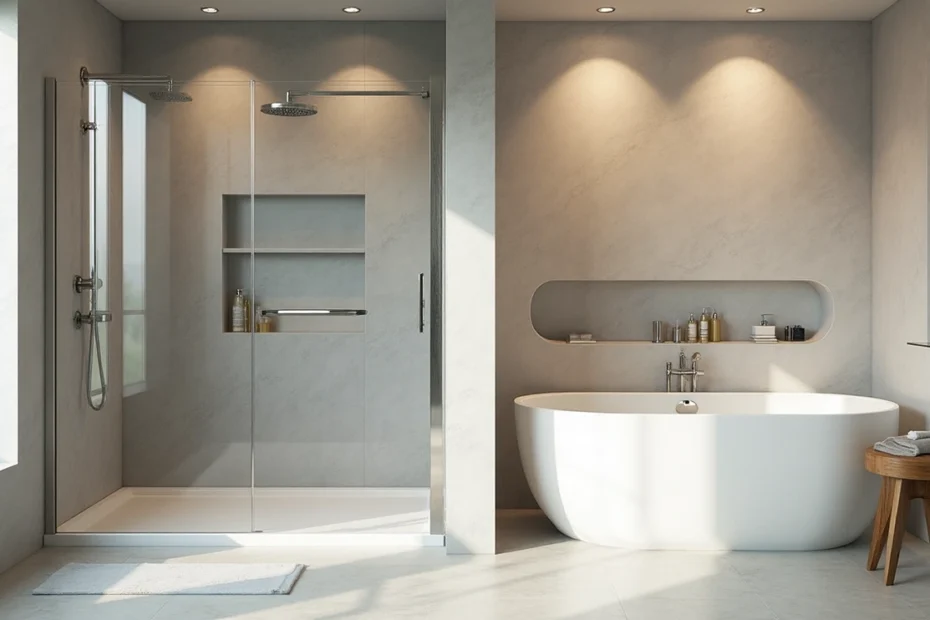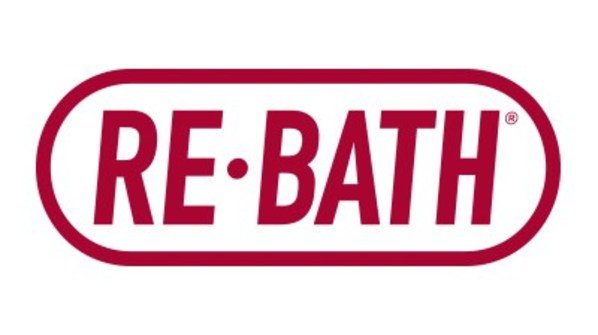Many homeowners ask us if a walk-in shower costs less than a tub during bathroom renovations. The answer isn’t simple. A tub-shower combo installation ranges from $4,500 to $9,000, while a new shower setup could cost anywhere from $6,500 to over $19,000. The original price tag tells only part of the story.
The choice between walk-in showers and bathtubs goes beyond just costs. Walk-in showers create an illusion of space in compact bathrooms, and large-scale tiles or slabs enhance this effect. It also helps that curbless showers offer both modern aesthetics and accessibility if you have mobility needs or use a wheelchair. To cite an instance, see how a single bathroom setup works best with both tub and shower options combined. Families love tub-shower combos because they blend quick shower convenience with relaxing bath possibilities in one unit.
This piece breaks down the complete cost comparison between bathtubs and walk-in showers. You’ll discover key design elements and find the perfect match for your home’s needs and budget.
Walk-in shower vs tub: key differences
A walk-in shower or tub? Your choice will shape your daily routine, bathroom functionality, and how happy you’ll be with your decision in the long run. Let’s look at what makes each option unique.
Design and layout
Space plays a crucial role in this decision. Walk-in showers need less floor space than tubs, which makes them perfect for smaller bathrooms. They create an open feel that makes your bathroom look bigger and more spacious. You can easily fit these showers into the space of a regular bathtub during renovations.
Bathtubs need more room to work with. A standard walk-in tub measures 52 to 60 inches long, 28 to 32 inches wide, and stands 38 to 46 inches tall. While they take up extra space, tubs give you plenty of room to enjoy a relaxing soak.
Accessibility and mobility
The biggest difference between these options comes down to accessibility. Walk-in showers shine with their low or zero-threshold entries. This design works great if you have mobility challenges or use a wheelchair. You won’t find any barriers to step over with curbless designs.
Walk-in tubs have lower entry points than regular tubs, but you’ll still need to step over a few inches. These tubs come with helpful features like molded seats for upright bathing, doors that swing outward for easier access, and wider door frames that give you more room to move.
Safety features comparison
Both options keep you safe in different ways. Walk-in showers excel with their barrier-free entry and work well with mobility aids. You can add grab bars, non-slip floors, and built-in benches to make them even safer.
Walk-in tubs include complete safety features right from the start. You’ll get handrails, non-slip floors, built-in seats, and anti-scald valves. The enclosed design helps prevent falls outside the bathing area. Some models clean themselves – a huge plus if bending is difficult.
Your best choice boils down to whether you feel safer standing in a shower or sitting in a tub.
Cost breakdown: bathtub vs walk-in shower

Money plays a crucial role in deciding between bathtubs and walk-in showers. Let’s look at the real costs beyond the original price tag to help you make a smart financial choice.
Initial purchase price
The upfront cost between these options varies quite a bit. A prefabricated shower unit ranges from $450 to $480 for materials alone, and standard bathtub materials cost between $500 and $1,100. The prices jump up quickly with custom options. Custom tile showers with glass doors need about $1,600 for materials, and larger soaker or jetted tubs start around $1,500.
Budget-conscious homeowners will find that prefabricated shower units are the most economical choice, while luxury models come with premium price tags.
Installation costs
Labor costs are higher than material expenses. A simple prefabricated shower installation costs between $365 and $450, and a standard bathtub installation runs $600 to $700.
Custom installations are a big deal as it means that the costs go up. A custom tile shower might cost $4,800 to $5,400 in labor. You’ll need several specialists like carpenters, plumbers, and drywall experts. Jetted tubs need extra electrical work that adds about $140 to your installation costs.
Maintenance and repair expenses
People often overlook the long-term upkeep costs. Bathtubs have one advantage—you can refinish or reglaze them to fix minor cosmetic issues like scratches and stains. Shower tiles, on the other hand, must be completely replaced when these problems show up.
Glass shower doors need regular cleaning and products to remove lime and calcium buildup. These ongoing maintenance needs add to your total ownership cost.
Water usage and utility bills
The most striking cost difference comes from daily use. A standard bath uses about 35-50 gallons of water, and soaker tubs use 80-100 gallons per bath.
A 10-minute shower with a low-flow showerhead uses about 20 gallons. Daily showers use about 9,125 gallons yearly compared to 14,600 gallons for daily baths.
These numbers affect your wallet directly—yearly water costs for daily showers average $64.54 versus $195.68 for daily baths. Daily baths cost almost three times more in water expenses than showers.
Pros and cons of each option
Let’s get into the good and bad points of both options. This will help you pick what works best with your lifestyle and plans.
Walk-in shower: pros and cons
Walk-in showers are super easy to clean with their flat surfaces and fewer corners where dirt builds up. You can customize them to fit any bathroom size, which makes them perfect for small spaces. These showers help people with mobility issues since there’s no need to step over a bathtub edge.
Walk-in showers do have some downsides. The open design can make you feel cold because air moves freely without doors or curtains. Water tends to splash beyond the shower area and create slippery spots. On top of that, shared bathrooms offer less privacy without an enclosure.
Walk-in tub: pros and cons
Walk-in tubs shine when it comes to safety. They come with built-in grab bars, anti-slip flooring, and comfortable seating. Their watertight doors and low thresholds (just a few inches) make falls much less likely than traditional tubs. Many models have therapeutic jets that help reduce joint pain.
These great features come with a price tag—walk-in tubs cost anywhere from $2,000 to $10,000 based on what you want. You’ll need to sit inside while the tub fills and drains, which takes about 15-20 minutes total. People who get cold easily might not enjoy this waiting time.
Which is better for resale value?
Taking out your only bathtub can hurt your home’s value. Families with small kids usually want a tub. A 2024 report shows homes with showers can sell for about $1,583 more than those with just bathtubs.
The best setup has both options. A five-piece bathroom that includes a double sink, walk-in shower, bathtub and toilet adds substantial value to your home. Bathroom updates give you the biggest bang for your buck when it comes to boosting resale value, according to Zillow data.
How to choose the right option for your home

The perfect bathroom choice depends on several important factors. Let’s take a closer look at how to find what works best in your situation.
Think over your space and layout
Your bathroom’s dimensions play a vital role when choosing between options. Tubs need more floor space and a horizontal layout, whereas showers can fit into tight corners. A custom tile shower with glass doors creates an illusion of openness in small bathrooms. You might want both a walk-in shower and tub in larger bathrooms to create a luxurious feel.
Think about current and future mobility needs
Smart investments include future-proofing your bathroom. ADA-compliant features help you age in place. Walk-in showers without curbs are safer if you have mobility challenges. Wheelchair users or people with mobility aids do better with open layouts that have minimal obstacles.
Assess your budget and renovation goals
The question goes beyond whether a walk-in shower costs less than a tub – you should think over your long-term plans. Buyers in family-oriented areas often want at least one bathtub. A walk-in shower might make more sense if you’re remodeling for retirement. Your future needs deserve attention even when they’re not immediate.
Alternatives if neither option fits
Tub cut-outs help reduce threshold height when traditional options don’t work. Shower chairs give you the option to sit while bathing. A tub-shower combo works well in homes with a variety of needs. Bath lifts add accessibility without major renovations.
Conclusion
Your specific needs, space constraints, and long-term goals will determine whether you should choose a walk-in shower or bathtub. This piece shows that walk-in showers need less water and maintenance. They also provide better accessibility for people with mobility challenges. But bathtubs give you therapeutic benefits, more privacy, and work better for families with children.
Your choices heavily influence the costs involved. Prefabricated options are budget-friendly, while custom installations can cost much more. The long-term water savings from showers matter too – they use nearly three times less water than baths.
Real estate experts suggest keeping at least one bathtub in your home, especially if you live in a family-friendly neighborhood. A five-piece bathroom with both options gives you the best return on investment.
Take an honest look at your lifestyle needs and future requirements before you decide. Think about how your mobility might change as you age. Are you planning to sell your home later? These answers will help you pick between a refreshing shower and a relaxing bathtub soak.
This choice shapes your daily comfort, home value, and water bills for years. Whether you want a sleek, space-saving walk-in shower or a therapeutic bathtub, your bathroom should match both your practical needs and personal priorities.


